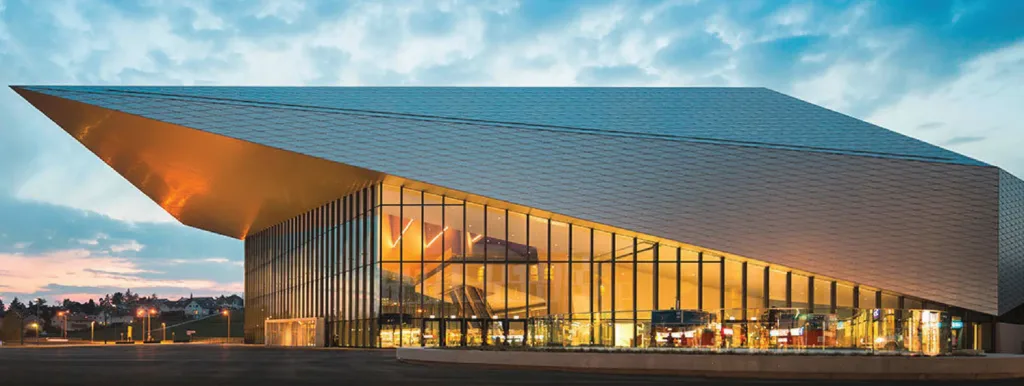

Transparent and semi-transparent Building-Integrated Photovoltaics (BIPV) are new ways to use solar energy in buildings. Unlike traditional opaque solar panels, transparent BIPV allows natural light to pass through while converting a portion of the solar spectrum into electricity. It means buildings can have natural light and clean energy both at the same time. It’s a clever way to mix energy-making with building design.
This innovative technology enables the transmission of visible light while efficiently converting ultraviolet and infrared light into electricity, offering a dual-purpose solution for energy generation and architectural design enhancement.
Benefits
The adoption of transparent and semi-transparent BIPV offers a multitude of benefits, including:
Optimal Space Utilization: Transparent BIPV maximizes architectural space by harnessing solar energy from building surfaces that were previously underutilized.
Energy Generation: By harnessing sunlight, transparent BIPV modules generate clean energy, reducing reliance on traditional power sources and mitigating carbon emissions. The semi-transparent BIPV windows not only solely generate electricity but also affect the buildings’ electricity usage through daylighting and heat gain/loss.
Aesthetic Integration: It preserves the visual appeal of buildings by seamlessly integrating solar cells into architectural elements.
Daylighting: Transparent and semi-transparent BIPV modules allow natural light to pass through while generating electricity, promoting daylighting and reducing reliance on artificial lighting.
Thermal Insulation: Many transparent BIPV modules incorporate low-emissivity coatings, providing improved thermal insulation and reducing cooling and heating loads.
Reduced Energy Costs: By generating on-site renewable energy and minimizing the need for artificial lighting, transparent BIPV can significantly reduce a building’s energy costs and carbon footprint.
Technology Behind Transparent BIPV
Transparent BIPV modules utilize specialized solar cells that allow light to pass through while generating electricity. These cells are often made from materials such as transparent crystalline silicon or thin-film amorphous silicon, which are engineered to maintain transparency without compromising energy conversion efficiency. Advanced manufacturing techniques enable the production of transparent solar modules with customizable shapes and patterns, offering versatility in architectural design.
Transparent BIPV technology employs various methods to achieve its unique characteristics. One popular approach is the use of thin-film solar cells, such as amorphous silicon or organic photovoltaic materials, deposited on transparent substrates like glass or polymers. These cells selectively absorb specific wavelengths of light while allowing others to pass through, resulting in a semi-transparent appearance.
PV technologies that are semi-transparent to the visible range of the solar spectrum and have a low cost and long life are mainly the thin-film technologies. In these, the PV cell thickness varies from a few nanometers (nm) to tens of micrometers. Semi-transparent PV cell thickness varies from a few nanometers to tens of micrometers.
The thickness of the film, the material used, the process of fabrication, and the deposition method define the grade of transparency of each different thin-film technology. The thin nature of such PV cells enables their adaptation into flexible modules, while also offering a uniform level of semi-transparency.
Some applications of Transparent and Semi-transparent BIPV
SwissTech Convention Center (Lausanne, Switzerland): Transparent, colored solar panels, (Graetzel cell technology), have been installed on the west façade of EPFL’s future SwissTech Convention Center. The design, by artists Daniel Schlaepfer and Catherine Bolle, has 5 different shades of red, green and orange, giving the ensemble a warm and dynamic aspect. The façade of this modern convention center incorporates transparent BIPV modules, showcasing the seamless integration of solar energy generation and architectural design.

SwissTech Convention Center, Switzerland
Bell Laboratories in Holmdel, NJ, U.S.A.- Bell Work’s renowned glass ceiling consists of more than 3000 individual panes of photovoltaic glass (amorphous silicon photovoltaic glass panes) spanning 60000 square feet, generating power to 20 percent of the property’s common areas and electric car charging stations. This system has the capacity can convert available sunlight into 180kW of reusable solar energy. These glass modules installed on the skylight provide this multipurpose building with a lot of natural illumination by capturing daylight and are also able to produce electricity free of CO2 emissions. It reduces the carbon footprint by preventing the emission into the atmosphere of approximately 60 tons of CO2 yearly.

Bell Labs, NJ, U.S.A.
Conclusion
Transparent and semi-transparent BIPV represents a transformative approach to solar energy integration in the built environment, offering a harmonious blend of functionality and aesthetics. With ongoing research and development focused on enhancing efficiency and durability, transparent BIPV holds immense potential to revolutionize the way buildings generate and utilize renewable energy, paving the way for a sustainable and visually appealing future.
About Ornate Solar
Ornate Solar is a leading solar company with 10 years of experience in the industry and the mission to reimagine the way solar is installed worldwide.
By not only partnering with the best-in-class solar brands but also developing our high-quality solutions (panels, solar inverter, accessories, and InRoof), we develop and deliver solutions that are modern, reliable, and effective.
If you are looking for high-quality solar solutions, reach out to us at 1200 2026 252 to discuss your options.










Do we haven more Opaque options for the Indian Climate?